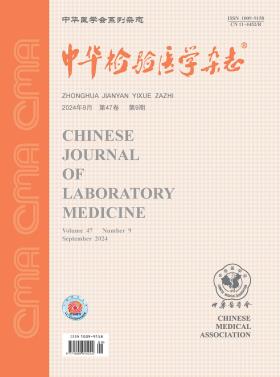Retinol-binding protein is an independent risk factor for hospitalization events in patients undergoing hemodialysis
Q4 Health Professions
引用次数: 0
Abstract
Objective To explore the risk factors related to hospitalization events in out patients on hemodialysis and to evaluate the effect of serum retinol-binding protein (RBP) level on hospitalization events in patients on hemodialysis. Methods Case-control study. A total of 80 patients on dialysis were recruited, including 47 men (58.8%) and 33 women (41.2%), with an average age of (60.9±11.7) years (range: 32-89 years) and a median dialysis age of 43.6 months. Dialysis-related data were collected, the serum RBP level was detected using the ELISA method. Patients were followed-up until June 30, 2019, to record the events associated with all kinds of hospitalization events. The t-test, Mann-Whitney U test and chi-square test were used to compare the differences between the hospitalized event group and the non-event group. Multivariate logistic regression was used to analyze the related risk factors of hospitalization events. The Kaplan-Meier method, Log-rank test, and Cox proportional hazards regression model were used to analyze survival data. Results During the 19-month follow-up period, 26/80 patients (32.5%) had 67 events of hospitalization. There was no difference (P>0.05) in age, sex composition, dialysis age, ratio of diabetes/hypertension, interval dialysis weight gain (IDWG), systolic/diastolic blood pressure before dialysis, kt/v and URR between the groups with or without hospitalization events. The cut-off point of serum RBP was calculated using the patient′s highest Youden index. The patients were divided into the high-RBP group (n=44) and low-RBP group (n=36) according to the level of 165.34 mg/L. The incidence of hospitalization events in the high-RBP group was higher than that in the low-RBP group (45.45%>16.67%, P=0.006). Using the multivariate logistic regression model, after adjusting for sex, age, albumin and total cholesterol (CHO), only the serum RBP level was independently correlated with hospitalization events. The high-RBP group had an odds ratio (OR) of 3.64 (95%CI, 1.14-11.58; P=0.029) compared with the low-level group in hospitalization events. The Kaplan-Meier survival analysis showed that the incidence of hospitalization events in the high-RBP group was significantly higher than that in the low-RBP group (P=0.0058). The test results of the multivariable Cox proportional hazards regression model showed that for patients on hemodialysis, an elevated serum RBP level is an independent risk factor for hospitalization events. Conclusion Elevated serum RBP level is correlated with hospitalization events in patients on hemodialysis. RBP is an independent risk factor for hospitalization events in outpatients on hemodialysis. Key words: Retinol-binding proteins; Renal dialysis; Risk factors视黄醇结合蛋白是血液透析患者住院事件的独立危险因素
目的探讨血液透析患者住院事件的相关危险因素,评价血清视黄醇结合蛋白(RBP)水平对血液透析患者住院事件的影响。方法病例-对照研究。共招募80例透析患者,其中男性47例(58.8%),女性33例(41.2%),平均年龄为(60.9±11.7)岁(范围:32-89岁),中位透析年龄为43.6个月。收集透析相关资料,采用ELISA法检测血清RBP水平。随访至2019年6月30日,记录与各类住院事件相关的事件。采用t检验、Mann-Whitney U检验和卡方检验比较住院事件组与非事件组的差异。采用多因素logistic回归分析住院事件的相关危险因素。采用Kaplan-Meier法、Log-rank检验和Cox比例风险回归模型对生存数据进行分析。结果随访19个月,26/80例患者(32.5%)发生67次住院事件。两组患者的年龄、性别构成、透析年龄、糖尿病/高血压比、透析间期增重(IDWG)、透析前收缩压/舒张压、kt/v、URR均无显著差异(P>0.05)。采用患者最高约登指数计算血清RBP分界点。按血药浓度165.34 mg/L分为高rbp组(n=44)和低rbp组(n=36)。高rbp组住院事件发生率高于低rbp组(45.45%>16.67%,P=0.006)。采用多因素logistic回归模型,在调整性别、年龄、白蛋白和总胆固醇(CHO)后,只有血清RBP水平与住院事件独立相关。高rbp组的优势比(OR)为3.64 (95%CI, 1.14-11.58;P=0.029)与低水平组住院事件比较。Kaplan-Meier生存分析显示,高rbp组住院事件发生率显著高于低rbp组(P=0.0058)。多变量Cox比例风险回归模型检验结果显示,对于血液透析患者,血清RBP水平升高是住院事件的独立危险因素。结论血液透析患者血清RBP水平升高与住院事件相关。RBP是血透门诊患者住院事件的独立危险因素。关键词:视黄醇结合蛋白;肾透析;风险因素
本文章由计算机程序翻译,如有差异,请以英文原文为准。
求助全文
约1分钟内获得全文
求助全文
来源期刊

中华检验医学杂志
Health Professions-Medical Laboratory Technology
CiteScore
0.40
自引率
0.00%
发文量
8037
期刊介绍:
 求助内容:
求助内容: 应助结果提醒方式:
应助结果提醒方式:


